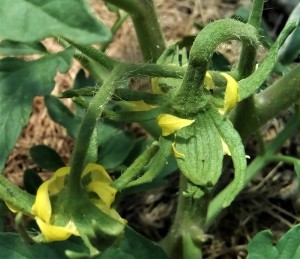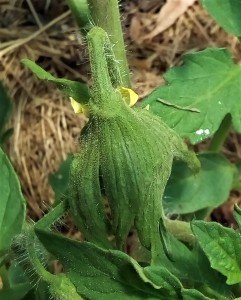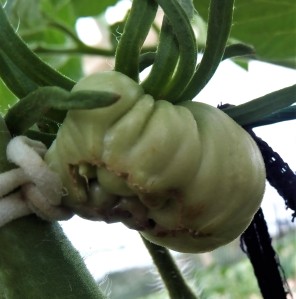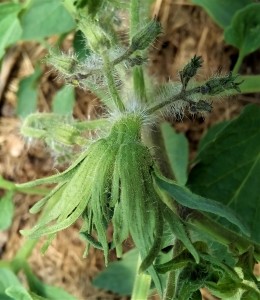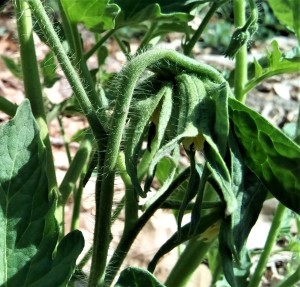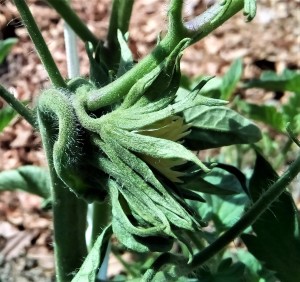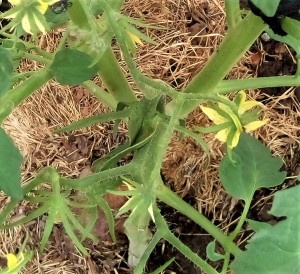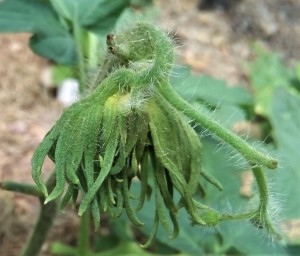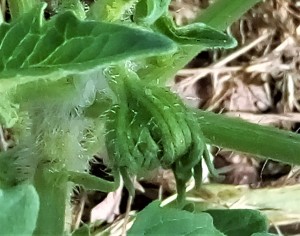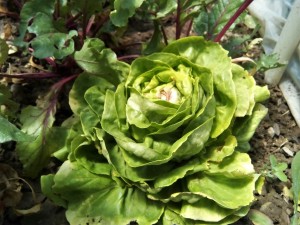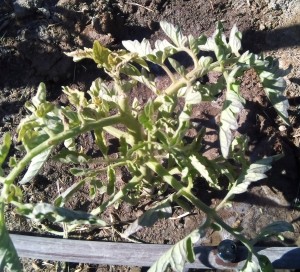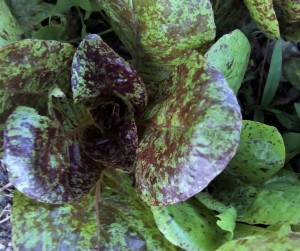I wish I had a complete answer to this major issue for all competitive growers of giant tomatoes! There are a number of other resources which address this issue, with insights from very experienced, elite growers. Perhaps the best resource on the Internet for ideas for growing giant tomatoes:
http://www.bigpumpkins.com/msgboard/ViewBoard.asp?b=33
With that introduction, here are some anecdotes from my experience. The year 2014 was my best year, with a 4.670 lb. Big Zac still holding the Utah state record. I’m trying to duplicate the conditions of that year, but I don’t have the very rich compost pile available to me, which was loaded with red wriggler worms. Anyhow, here is what seems to be working
- Start with seeds from proven lineages – parent fruit documented to produce megablooms and large fruit
- Good soil prep – around here (dense, alkaline clay as native soil) this means peat moss, compost (including lots of spent mushroom compost this year), slow release fertilizer, kelp meal, trace minerals, mycorrhizal fungal spores
- A high tunnel to warm soil and get seedlings off to a vigorous, rapid start
- Fish emulsion (two doses so far) or some other formulation to jump start growth
- Vibrating toothbrush or other means to fully pollinate flowers – megablooms can be a real challenge to get fully pollinated.
If you know of any useful additions to this list, especially details about brand names and dose rates of products, please do let me know: dale@gianttomatoseeds.com
So we’ve had a few days of “tomato-like” weather, with highs in the 75-85° F range. This is uncommon in this climate of the high desert. Typically, high temperatures in late Spring around here skip the 80’s and go straight into the 90’s and 100’s. It’s too early to tell if this spell of good weather will result in HUGE tomatoes in a couple of months, as none of these megablooms have set fruit yet.
Below is a video overview of the giant tomato project as of 6-20-2018, followed by closeup pictures of individual megablooms – well, “megabuds” anyhow, as most of have not even begun to open yet.
So here is a countdown of the “Top 10” megablooms as of June 20th. [Followed by updates on July 16th]
10. Gold Medal – 3X (estimating that three ovaries are fused into one blossom – really hard to tell for sure without dissection under a microscope – and I ain’t doin’ dat!)
Update July 16th – fruit growing, but not fast:
9. KY Cygni – 3X
Update July 16th – blossom aborted, as did most others, despite repeated efforts at pollinating with an electric toothbrush. Either it got too hot, or the flower thrips are eating all the pollen before pollination can occur.
8. Westerlund – 3X
Update July 16th – blossom aborted
7. Bigzarro – 4X
Update July 16th – This one took! And is looking very much like its parent, but is not growing very fast –
See extensive documentation of parent fruit at:
https://delectationoftomatoes.wordpress.com/2014/07/25/how-big-will-that-tomato-get/
6. Megamutt (5.24 Borgers 2017) – 4X
Update July 16th – Fruit set, but growing very slowly:
5. Tamara – 4X and the most hefty of all
Update July 16th – Growing, albeit slowly:
4. Michael’s Portuguese Monster – 5X
Update July 16th – blossom aborted
3. Big Zac (2.41 Ritchie 2016) – 5X
Update July 16th – This one also took, but apparently did not pollinate well:
2. Nesravnennyi – 6X, 20+ sepals
Update July 16th – blossom aborted
And (drumroll), my number 1 most promising blossom, the one most likely to push me over that elusive 5-pound barrier – at least at this very early point in the season –
1.Domingo (3.420 DT 2017) – 6X, 22+ sepals
Update July 16th – blossom is still alive; if there was any pollination, it was minimal. There is little hope of getting anything significant out of this:
It will be a real challenge to get these pollinated, as 98° is predicted just 4 days out – about the time most of these will be opening. Time for the shade cloth again!
More to come…
Update 6-25
Honorable mention is a possible 10X on a variety from Russia simply labeled, “Ruttgers”. This is clearly NOT the same as “Rutgers”, a common, little, old commercial variety. It could be that it is named after someone with the surname Rüttgers? Research needed…
Anyhow, this very impressive megabloom is apparently splitting into at least three separate sections or lobes. Sewing the sections back together before or after fruit set maybe will not work. Um, maybe I won’t even try such a stitching trick, not yet…
Here is a picture of the parent fruit of this Ruttgers plant from 2015 – grown in the open field under poor, very weedy conditions with no pruning or special care, reaching 2.370 lb. – perhaps some potential here!?
Update July 16th –
Recent pictures loaded and commented on above. Pollination has been very disappointing. I’ve attempted pollinating with a battery-powered vibrating toothbrush as many as 20 times on these blossoms, to no or little avail. It has just been too hot. I’ve scarcely observed even a grain of pollen.
Following are pictures of a couple of random megablooms out in the main tomato patch.
Giant Monster –
Alice’s Dream –
In the high tunnel, a 2X megabloom from Sibirskiy Velikan Rozovyi, which did not make the original “Top 10” list above, has set fruit:
Among the 25 vines in the later planting in the high tunnel, only one has developed a promising looking megabloom so far, Big Zac (3.29 Borgers 2017); but unfortunately, this one too seems to be aborting:




